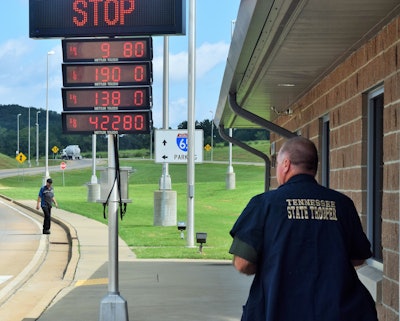 Tennessee Highway Patrol Sergeant David Mills works the Giles County inspection station, opened in recent years on I-65 NB just across the Alabama line with large inspection bays, sophisticated weigh-in-motion and scanning equipment and a special around-scale bypass lane.
Tennessee Highway Patrol Sergeant David Mills works the Giles County inspection station, opened in recent years on I-65 NB just across the Alabama line with large inspection bays, sophisticated weigh-in-motion and scanning equipment and a special around-scale bypass lane.Prior to 2004, the Tennessee Highway Patrol main and Commercial Vehicle Enforcement units were separate entities under the state Department of Public Safety. That year, DPS officials and the State Legislature merged the two units.
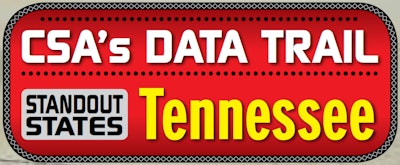 Access interactive maps charting state rankings in a bevy of violation/inspection categories via OverdriveOnline.com/CSA, newly updated with calendar year 2017 data. Also there, download a full 48-state report.
Access interactive maps charting state rankings in a bevy of violation/inspection categories via OverdriveOnline.com/CSA, newly updated with calendar year 2017 data. Also there, download a full 48-state report.CVE then began training all its road troopers to conduct Level 1 (full) or Level 3 (driver) Commercial Vehicle Safety Alliance North American Standard Inspections. “All road troopers are certified” now to inspect, says Capt. Brandon Douglas, the federal Motor Carrier Safety Assistance Program leader in the state.
That makes for quite a force. The state has as many as 900 or more potential inspectors for your truck as it travels Interstate highways 40, 75, 65, 24 and 69 — not to mention 55 in Memphis, 155 in Dyersburg, 81 at its southwestern genesis and 26 at its terminus in Northeast Tennessee.
Odds are pretty good, though, that your Tennessee inspection will turn out violation-free. That’s how nearly six in 10 such inspections end in the state, based on 2017 inspection and violation data mined by RigDig Business Intelligence and Overdrive, both owned by Randall-Reilly. Tennessee’s percentage of
clean inspections is so high, in fact, that it ranks behind just six other states for the proclivity.
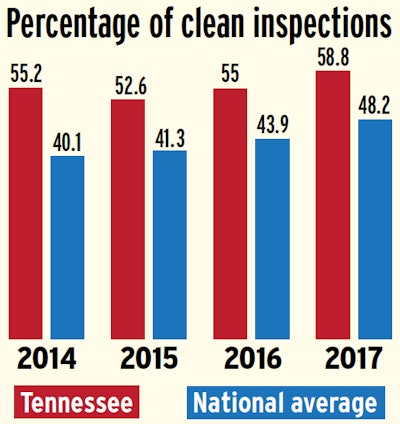 Tennessee is among the most beneficial states for truckers when it comes to clean inspections. More than half of Tennessee’s inspections in the last four full calendar years occurred with no violation whatsoever.
Tennessee is among the most beneficial states for truckers when it comes to clean inspections. More than half of Tennessee’s inspections in the last four full calendar years occurred with no violation whatsoever.In some ways, the marked growth in Tennessee’s clean inspection percentage mirrors what’s been happening nationwide as truckers button up their operations on the one hand, while inspectors take the time to finish a clean inspection on the other. Douglas also speculates that the turn to electronic logging devices for hours recording has had some part in driving the growth in clean inspections. “A lot of violations with the log book were form and manner,” he says. “ELDs have taken a lot of those away,” resulting in more clean Level 3 driver inspections particularly.

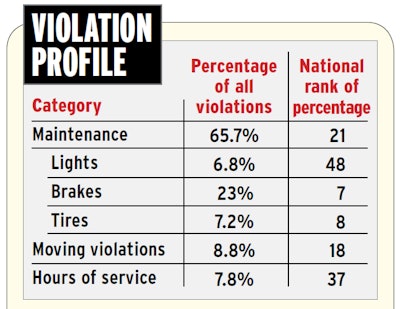 Source: Unless otherwise noted, all numbers based on 2017 federal data analyzed by RigDig Business Intelligence (rigdig.com/bi).
Source: Unless otherwise noted, all numbers based on 2017 federal data analyzed by RigDig Business Intelligence (rigdig.com/bi).With eight weigh stations spread around six counties, state inspectors distribute their troopers’ activity fairly equally around those sites and the roadside. In 2017, 54 percent of Tennessee’s total 69,323 inspections of for-hire trucking companies were conducted at a fixed location, the balance at the roadside.
Resulting violations numbers have continued to fall in each of the last few years. As Douglas notes, the uptake of ELDs and fall in hours of service violations play roles, but it’s perhaps of a piece with new initiatives the state is putting on four-wheelers’ interactions with big trucks.
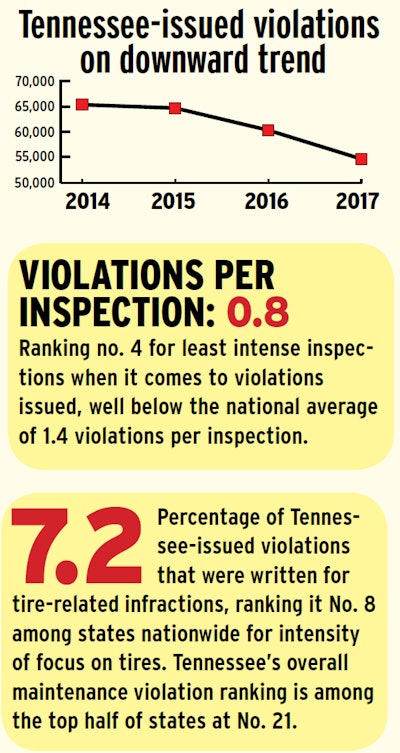
Lt. Bill Miller, THP’s lead public information officer, says troopers are recommitting to enforcement activities and messaging toward the general public with regard to truck safety.
“The overwhelming number of crashes are not necessarily the truck driver’s fault,” Miller says. “We’re
re-emphasizing the educational aspects” of enforcement and “educating motorists in general. As young teens get their Class D license, they don’t get much if any instruction” on safe practices around trucks.
Find all of the CSA’s Data Trail state profiles via the links below:












